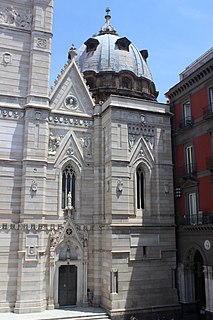
Naples is the regional capital of Campania and the third-largest city of Italy, after Rome and Milan, with a population of 967,069 within the city's administrative limits as of 2017. Its province-level municipality is the third-most populous metropolitan city in Italy with a population of 3,115,320 residents, and its metropolitan area is the second-most populous metropolitan area in Italy and the 7th-most populous urban area in the European Union.

The Catacombs of Rome are ancient catacombs, underground burial places in and around Rome, of which there are at least forty, some rediscovered only in recent decades. Though most famous for Christian burials, either in separate catacombs or mixed together, Jews and also adherents of a variety of pagan Roman religions were buried in catacombs, beginning in the 2nd century AD, occasioned by the ancient Roman ban on burials within a city, and also as a response to overcrowding and shortage of land. The most extensive and perhaps the best known is the Christian Catacomb of Callixtus located near the Park of the Caffarella, but there are other sites, both Christian and not, scattered around the city, some of which are now engulfed in the modern urban sprawl.

Januarius, also known as Januarius I of Benevento, was Bishop of Benevento and is a martyr and saint of the Catholic Church and the Eastern Orthodox Church. While no contemporary sources on his life are preserved, later sources and legends claim that he died during the Great Persecution which ended with Diocletian's retirement in 305.
Saint Proculus (Proclus) of Pozzuoli was martyred around 305 AD, according to Christian tradition, at the same time as Saint Januarius.

Naples Metropolitan Archcathedral or The Metropolitan Archcathedral of the Assumption of Mary, is a Roman Catholic cathedral, the main church of Naples, southern Italy, and the seat of the Metropolitan Archbishop of Naples. It is widely known as the Cattedrale di San Gennaro, in honour of Saint Januarius, the city's patron saint.

San Gennaro dei Poveri is a former monastery and church complex, later converted into a hospital for indigent located on Via San Gennaro dei Poveri #25 in the Rione Sanità, of the city of Naples, Italy. The elongaged complex rises towards Capodimonte, lying just south of the domed Basilica dell'Incoronata Madre del Buon Consiglio.

The Catacombs of San Gennaro are underground paleo-Christian burial and worship sites in Naples, Italy, carved out of tuff, a porous stone. They are situated in the northern part of the city, on the slope leading up to Capodimonte, consisting of two levels, San Gennaro Superiore, and San Gennaro Inferiore. The catacombs lie under the Rione Sanità neighborhood of Naples, sometimes called the "Valley of the Dead". The site is now easily identified by the large church of Madre del Buon Consiglio.
Saint Agrippinus (Arpinus) of Naples was a bishop of Naples and is venerated in that city as a saint. According to tradition, Agrippinus was the sixth bishop of Naples. He lived at the end of the 3rd century, and seems not to have been a martyr.

Aspren or Asprenas was a 1st-century Christian saint and venerated as the first Bishop of Naples.

Saint Severus was a bishop of Naples during the 4th and 5th centuries. He is considered the twelfth bishop of Naples, succeeding Maximus. His episcopate ran from February 363 to April 29, 409, the traditional date of his death. Maximus is actually considered the 10th bishop by the Catholic Church; between the episcopates of Maximus and Severus was the episcopate of Zosimus, who was Arian and thus considered heretical by the Catholic Church.

University of Naples "L'Orientale", is a university located in Naples, Italy. It was founded in 1732 by Matteo Ripa and is organized in 4 Faculties. It is the oldest school of Sinology and Oriental Studies of the European continent and the main university in Italy specialized in the study of non-European languages and cultures, with research and studies agreements with universities from all over the world. It is one of the most prestigious universities in the world regarding Asian cultures and languages.

Christianity and religion in general has always been an important part of the social and cultural life of Naples. It is the seat of the Archdiocese of Naples, and the Catholic faith is highly important to the people of Naples and there are hundreds of historic churches in the city. The Cathedral of Naples is the most important place of worship in the city, each year on September 19 it hosts the Miracle of Saint Januarius, the city's patron saint. In the miracle which thousands of Neapolitans flock to witness, the dried blood of Januarius is said to turn to liquid when brought close to relics said to be of his body: this is one of the most important traditions for Neapolitans.

Rione Sanità is a neighbourhood in Naples, part of the Stella quarter. It is located north of Naples' historical centre, adjacent to the Capodimonte hill.

The Ospedale degli Incurabili or Complesso degli Incurabili is an ancient and prominent hospital complex located on Via Maria Longo in central Naples, Italy. Part of the complex, including the remarkable pharmacy, are now the Museo delle arti sanitarie of Naples.

The Royal Chapel of the Treasure of St. Januarius, or the Reale cappella del Tesoro di San Gennaro, is a chapel located in the Cathedral of Naples, Italy, and dedicated to St. Januarius, patron saint of the city. This is the most lavishly decorated chapel in the Cathedral, and contains contributions by the premier Baroque artists in Naples.

Santa Maria della Sapienza is a Roman Catholic church, located on Via Costantinopoli in central Naples, Italy.

The Basilica of San Giovanni Maggiore is a church in Largo San Giovanni Maggiore in central Naples, Italy.

The Catacombs of Saint Gaudiosus are underground paleo-Christian burial sites, located in the northern area of the city of Naples.
San Gennaro usually refers to St Januarius, bishop of Naples.
Naples and its immediate surroundings preserve an archaeological heritage of inestimable value and among the best in the world. For example, the archaeological park of the Phlegraean Fields are directly connected to the centre of Naples through the Cumana railway; also the nearby sites of Pompeii, Herculaneum, Stabiae and Oplontis are among the World Heritage sites of UNESCO.


















